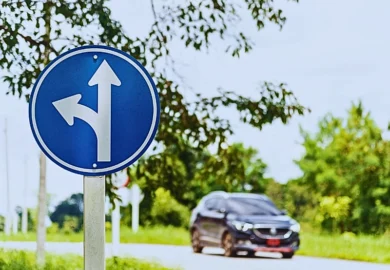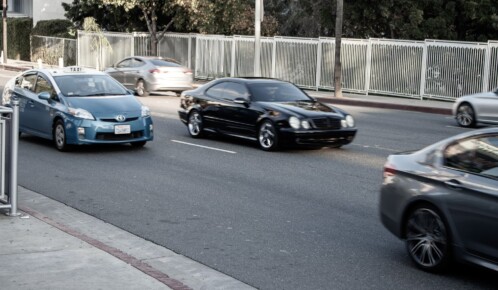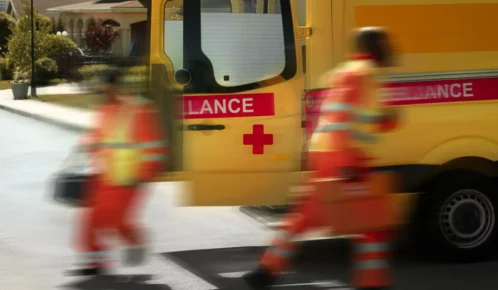People involved in an accident where a driver was turning may ask, “Who’s liable in a left-turn car crash in Illinois?” The driver making a left turn is often liable for failing to give way to oncoming traffic. The state fault rules, however, recognize various circumstances in which liability may be shifted or shared.
Table of Contents

The input of an experienced lawyer is necessary to identify the liable party and navigate the insurance or lawsuit process. Seasoned accident attorneys at Ankin Law understand Illinois’ fault rules and will leverage their experience to fight for your rightful compensation. Call us at 312-600-0000 to discuss your case.
Who Is at Fault in a Left-Turn Car Accident in Illinois?
In Illinois, oncoming vehicles have the right of way at intersections. Thus, the driver turning left is usually at fault for a left-turn accident. The turning vehicle bears liability because of the driver’s failure to yield to the cars moving straight. But, there are circumstances in which they may be partially at fault or not liable. These situations include when:
- The driver approaching the intersection was driving above the set limit.
- The oncoming vehicle ignored a red light signal and crashed into the vehicle turning left.
- The vehicle maneuvering the turn made a legal turn, but an unexpected event occurred, making stopping or slowing down impossible.
What Evidence Can Prove Liability in a Left-Turn Collision?
You must present solid evidence showing that the other party’s negligence caused the crash. You must also establish causation. In other words, you must show that your injuries were direct results of the collision.
Knowing what to expect during a car accident case allows you to objectively gather the evidence that can strengthen your case. Examples of evidence you can present in a left-turn collision claim include:
Traffic Surveillance Footage
The traffic surveillance footage at the intersection can provide crucial details of the moments leading up to the accident. The video can show how the driver maneuvered the turn, the speed of the oncoming vehicle, and the time of the accident.
Traffic-Light Records
The documentation on the traffic-light sequence and duration can shed light on who had the right of way when the Chicago left-turn car crash occurred.
Skid Mark Analysis
Tire marks on the road can also reveal crucial facts about the accident. They can show the at-fault party’s braking distance and vehicle speeds. They can also provide insights into the at-fault driver’s actions (or inaction) in preventing the collision. Investigators often rely on such evidence to reconstruct the accident scene.
Vehicle Damage Pattern
The impact point and the state of the vehicles involved in the collision can also help prove left-turn accident liability. Accident investigators may estimate vehicle speed and turning radius based on damage patterns.
Mobile Phone Data
Data retrieved from a driver’s mobile phone may show prohibited actions when driving, such as texting. Along with operating the stereo system, texting and calling can distract a driver. An accident can occur even in a preventable situation if the driver is engaging in distracting activities.
Accessing some of these pieces of evidence can be challenging for a non-lawyer. Fortunately, a motor vehicle accident lawyer has access to resources and legal tools to obtain evidence, such as video surveillance, traffic light data, and mobile phone records, from relevant parties.
Common Causes of Left-Turn Crashes
Left-turn crashes accounted for up to 39% of all accidents in 2023 that resulted in pedestrian injuries and fatalities. Common causes of left-turn crashes include:
Driver’s Failure to Check Blind Spots
A vehicle’s mirror has a limited scope of view. Failure to check the blind spot may result in a collision. Take the busy intersection of North Michigan Ave. and East Ontario St, for example. Many left-turning motorists are prone to hitting pedestrians walking in the blind spot zone.
Turning Left with Obstructed Views
Another cause of left-turn crashes is obstructed views. A vehicle’s A-pillar blocks a driver’s view of the road. It obstructs the view between the driver’s window and the windshield. Therefore, a driver may not see a pedestrian because the A-pillar blocks their view.
Illegal Turns
Illegal maneuvering may include turning from the wrong lane or at an intersection with a “No-Turn” sign. Failure to yield is a clear violation of Chicago’s traffic laws because such acts cause traffic collisions. Even in such a case, the at-fault party’s insurer may show unwillingness to settle or try to shift liability to you. That’s why you need a lawyer to prove you are not at fault.
Misjudging the Gap or Speed of Oncoming Vehicles
Generally, drivers turning left cover larger turning radii than those turning right. Thus, most of them have to maneuver left turns at slightly higher speeds. Before turning, motorists must find gaps between oncoming cars traveling at different speeds in multiple streams. In such a situation, they may misjudge the gap and speed of oncoming vehicles. Such a miscalculation can lead to an accident.
Motor vehicle accident lawyers at Ankin Law are on standby to represent you and protect your rights and best interests if you have been harmed in a left-turn accident. We will present evidence-backed arguments to prove the other party’s liability and ensure you get fair compensation. Contact us today to schedule a free consultation.
Frequently Asked Questions (FAQs)
Is the driver turning left always at fault in a crash?
Sometimes the blame might shift to another motorist, rather than fall on the driver turning left. One example is when the oncoming car runs a red light or exceeds the recommended speed limit.
Can both drivers share fault in a left-turn accident?
In Illinois, the burden of yielding falls on the left-turning drivers. Drivers may, however, share liability based on their level of contribution to the crash.
How does comparative negligence affect left-turn accident claims in Illinois?
Illinois follows the “modified comparative negligence” law. Under this rule, you can only pursue compensation if you contributed less than 50% to the accident. Your compensation will, however, be reduced by your contribution to the accident. You will not receive any compensation if your percentage of fault was 50% or more.



